ICP-MS Analysis of Heavy Metals in Hemp-Containing Beverages
Standardization

Calibration

Sample Digestion

Measurement & Analysis

A complete workflow has been developed for the analysis of a total of twelve heavy metals in hemp-containing beverage products. This workflow includes the following:
- Preparation of standard, blank, and beverage sample solutions
- Preparation of calibration solutions using a metal mix standard solution
- Conditions for rapid microwave sample digestion
- Setup of ICP-MS system
- Analysis of heavy metal content of six different beverage samples containing hemp including determination of recovery rate
Introduction
Hemp (or: industrial hemp) and cannabis are strains of the Cannabis sativa plant differentiated based on total
delta-9-tetrahydrocannabinol (delta-9-THC) content (delta-9-THC and tetrahydrocannabinolic acid (THCA)). Cannabis sativa plant material that exceeds 0.3% wt/wt THC on a dry weight basis is considered marijuana (cannabis) under the US Controlled Substances Act. Industrial hemp is Cannabis sativa L. with a THC threshold below 0.3% (= % THCA x 0.877 + % delta-9-THC). Definitions of hemp and cannabis are regulated in a specific manner in many parts of the world. In this work, various beverage products containing hemp have been analyzed, but all descriptions are valid for cannabis-containing beverages as well.
Hemp is known to accumulate heavy metals, such as lead, cadmium, arsenic, mercury, chromium, or nickel in its roots, shoots, buds, and seeds. It is also known to be used for the remediation of contaminated soil (phytoremediation and phytoextraction).1,2,3,4 Due to the potentially hazardous effects of these metals, this property may of course hinder the use of hemp in, e.g., beverage or cosmetics industries. In addition, product contamination can also occur during the manufacturing process. Therefore, beverage or personal care products containing hemp must be tested for their heavy metal content.
This report describes the analysis of arsenic, cadmium, mercury, and lead (elements typically referred to as the “big four”) as well as of chromium, barium, silver, selenium, antimony, copper, nickel, and zinc by inductively coupled plasma coupled to mass spectrometry (ICP-MS). A premixed metal standard solution containing these twelve heavy metals was utilized – an approach that is simple and that covers a broad range of analytes. Depending on specific lab needs, it can be supplemented by additional element standards – or replaced by a heavy metal mix only containing the “big four”. In total, six different beverage samples containing hemp were analyzed:
- CBD drink (containing “cannabidiol extract”, 1.170 g/L cannabidiol)
- Hemp energy drink (with an infusion of cannabinoid-reduced hemp)
- Cannabis iced tea (with cannabis extract)
- CBD lemon-lime drink (with Cannabis sativa extract, 40 mg/L cannabidiol)
- Cannabis beer (with Cannabis sativa extract)
- Hemp mead (contains macerated hemp seed)
Experimental Procedure
Preparation of Internal Standard, Blank, and Beverage Sample Solutions
All six beverages were liquid and did not contain any solid components such as fruit zest or deposited particles. Therefore, no sample homogenization or filtration was conducted. All the samples containing carbon dioxide were degassed for 30 minutes in an ultrasonic bath prior preparation of sample solutions.
- General: Use single-channel pipettes with variable volume and gravimetrically tested polypropylene pipette tips for reagent, standard, and sample transfers.
- Indium standard solution (internal standard): Pipette 3 mL nitric acid 65% and 1000 µL of indium ICP standard (1000 mg/L) into a 100 mL volumetric quartz flask. Fill the flask to mark with ultrapure water to obtain a final concentration of 10 µg/mL. Note: Rhodium ICP standard may also be used as an alternative internal standard.
- Blank solution: Pipette 2 mL nitric acid 65% and 2 mL ultrapure water into a 15 mL quartz microwave digestion vial and digest using a microwave digestion system (for conditions see the section below). After completing digestion, quantitatively transfer the solution into a 50 mL polypropylene tube, combine it with a 50 µL of indium standard solution and fill up to 50 mL with ultrapure water.
- Sample solution: Pipette 1 mL of beverage sample into a 15 mL microwave quartz vial. Add 2 mL of 65% nitric acid, 1 mL of ultrapure water, and digest the sample utilizing a microwave digestion system. After completing digestion, quantitatively transfer the obtained solution into a 50 mL polypropylene tube, combine it with a 50 µL of indium standard solution and fill up to 50 mL with ultrapure water.
Calibration: Preparation of Heavy Metal Standard Addition Solutions
To compensate for sample matrix effects, a standard addition method utilizing a Certified Reference Material (CRM) Metal mix I for cannabis testing standard solution was applied for the preparation of all calibration curves. The final calibration curve is comprised of four data points (three standard addition solutions plus a sample solution).
Preparation of ICP Calibration Standards
- Pipette 1 mL of liquid beverage sample into a 15 mL microwave quartz vial.
- Add 2 mL nitric acid 65%, 1 mL ultrapure water, and different volumes of CRM Metal mix I for cannabis testing standard solution (see table below) and digest the sample using a microwave digestion system.
- After completed digestion, quantitatively transfer the obtained solution into a 50 mL polypropylene tube, combine it with a 50 µL of indium standard solution and fill up to 50 mL with ultrapure water.
- Subject the resulting sample to ICP-MS analysis.
Preparation of Standard Addition Solutions
Preparation of standard addition solutions using Metal mix I for cannabis testing Standard Solution (As, Cd, Hg, Pb, Ag, Cr, Cu, Co, Ni, Sb and Se)
The metal mix I for cannabis testing was diluted by a factor of 1:10 using ultrapure water.
Instrument Parameters
Beverage Sample Digestion Parameters
After digestion, the obtained solution should be clear. Conditions must be adapted to the specific microwave system used.
ICP-MS Conditions
The analysis was performed in the sequence: Blank, samples 1 – x, addition solutions.
Calibration Data
Standard addition solutions were prepared utilizing Metal mix I for cannabis testing standard solution (As, Cd, Hg, Pb, Ag, Ba, Cr, Cu, Co, Ni, Sb, Se, Zn). Shown are the results obtained for the CBD lemon-lime drink sample. These revealed excellent linearity over the entire calibration range, with R2 values of > 0.9997 for all metals but lead (0.9963). The latter can be considered uncritical, as all analysis results are below the LOD of 0.5 µg/mL and corresponding recovery rates are excellent (see results section). Comparable results were achieved with all other hemp-containing beverage samples.
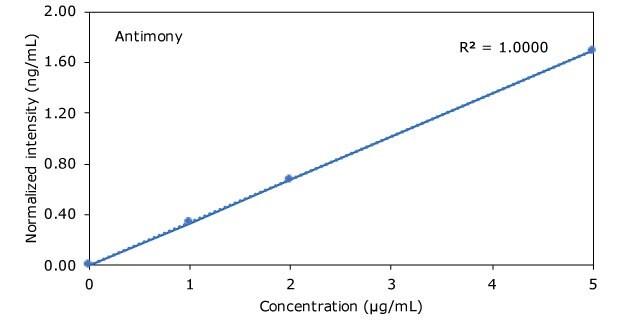
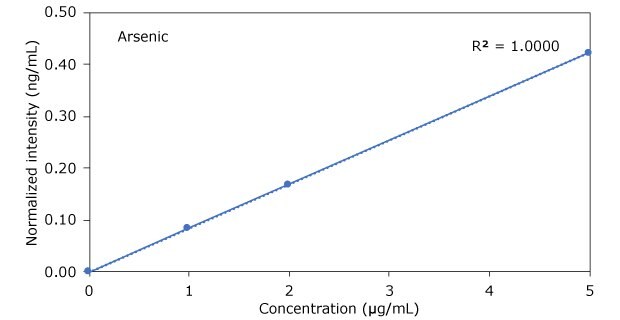
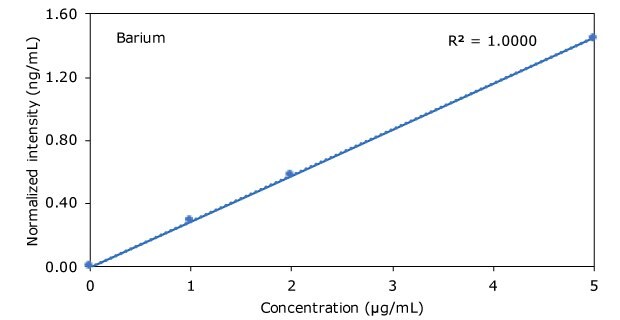
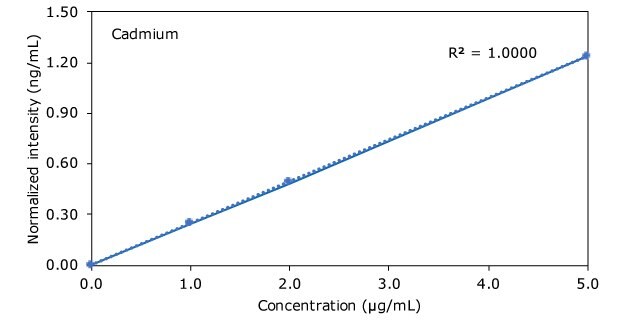
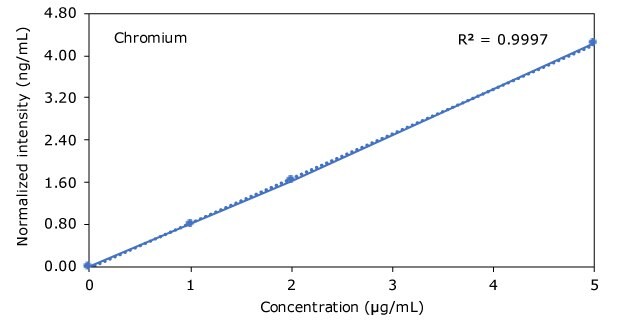
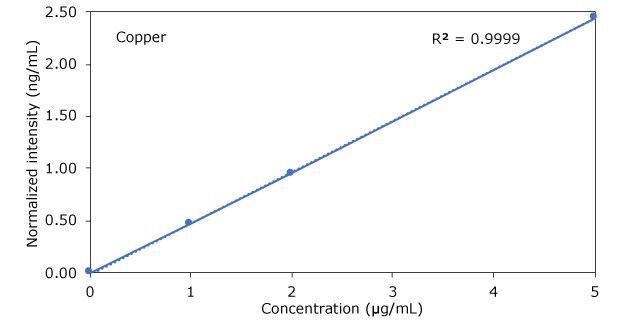
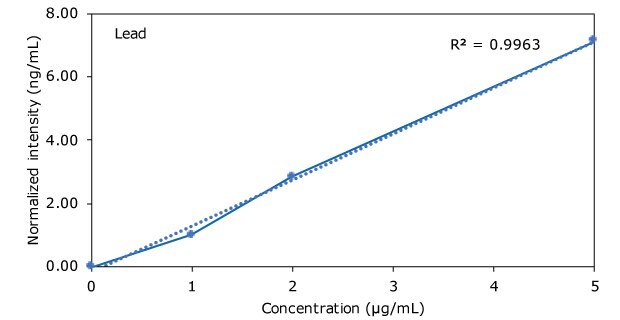
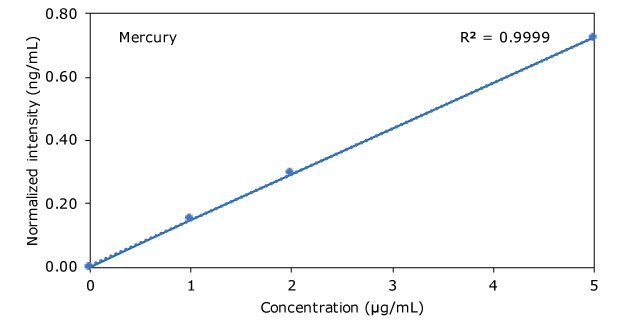
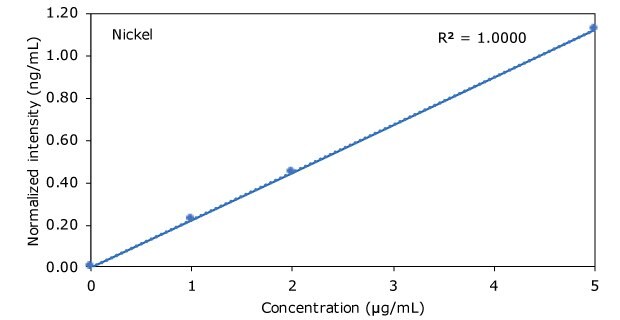
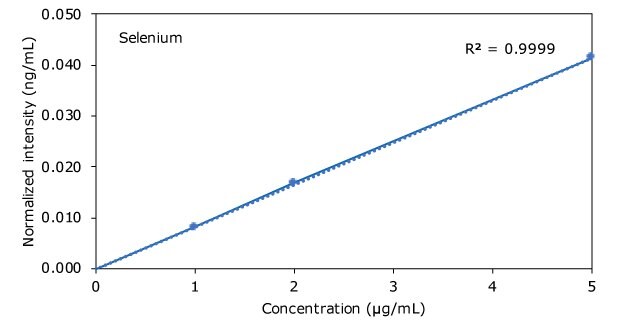
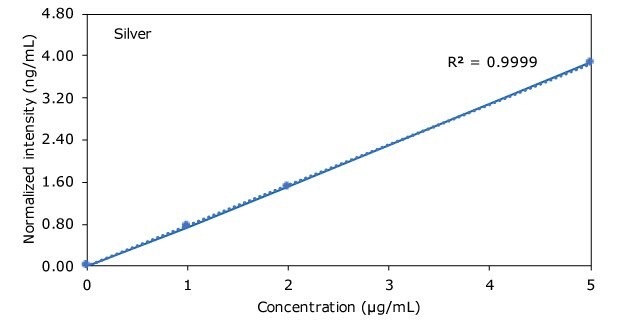
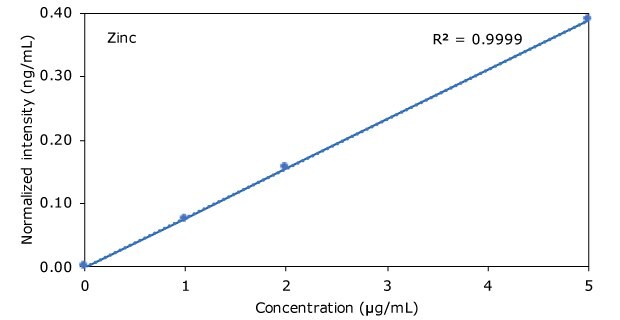
Figure 1. Calibration curves for As, Cd, Hg, Pb, Ag, Ba, Cr, Cu, Co, Ni, Sb, Se, and Zn obtained on the analysis of four standard addition solutions.
Results
All hemp-containing beverage samples were analyzed by ICP-MS and as duplicates. The recovery rate (RR) for the samples was determined using Metal mix I for cannabis testing standard solution. RRs for all heavy metals were in the range of ±7% or better.
CBD Drink
Hemp Energy Drink
Cannabis Iced Tea
CBD Lemon-Lime Drink
Cannabis Beer
Hemp Mead
Three out of six beverage samples did not contain any of the twelve heavy metals analyzed. In the hemp energy drink, only zinc was detected (0.1 µg/mL). The antimony, arsenic, chromium, lead, nickel, selenium, and silver content of all the samples was below the limit of detection (Ag: 1.0 µg/mL, Pb: 0.5 µg/mL, all others: 0.1 µg/mL). The CBD drink and the hemp mead samples contained detectable amounts of either one of the metals barium, cadmium, copper, mercury, and zinc, with concentrations of 1.5 µg/mL (Ba), 0.3 µg/mL (Cd), 0.2 – 0.4 µg/mL (Cu), 0.2 µg/mL (Hg) and 1.4 µg/mL (Zn), respectively.
Conclusion
This work demonstrates a comprehensive ICP-MS workflow, using the standard addition calibration method, for the determination of heavy metals in hemp-containing beverage products. Crucial elements in the process include the use of an accurately traceable Certified Reference Material metal mix. Samples were digested utilizing a specific digestion protocol optimized to provide clear digestion solutions. The resulting solutions were subjected to ICP-MS analysis. Calibration data was obtained by the preparation and analysis of standard addition solutions obtained by utilizing a CRM metal mix containing twelve metals and heavy metals (arsenic, cadmium, lead and mercury, silver, barium, chromium, copper, cobalt, nickel, antimony, selenium, and zinc).
The final results were consistent and revealed the content of Sb, As, Pb, Hg, Se, and Ag in all the samples below the limit of detection. But the barium, copper, nickel, and zinc concentrations ranged from 0.1 – 38 µg/g, chromium content between 0.1 – 0.3 µg/g (not detected in cereals), and the cadmium concentration of 0.07 – 1.0 µg/g (chocolate and chocolate covered hempseed).
Related Materials
References
To continue reading please sign in or create an account.
Don't Have An Account?